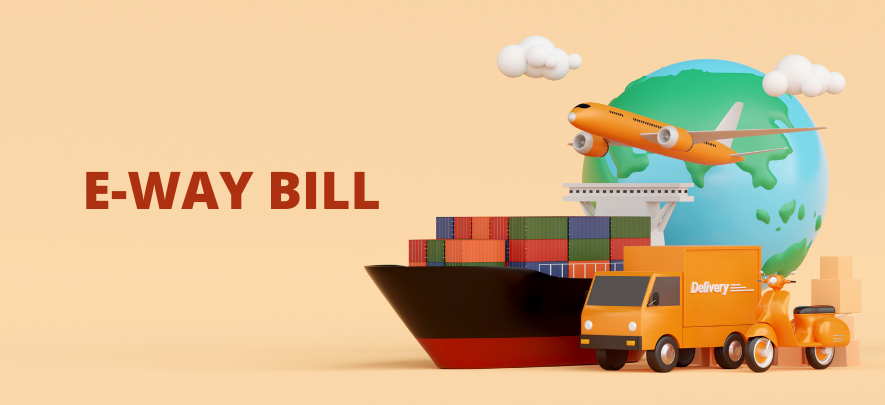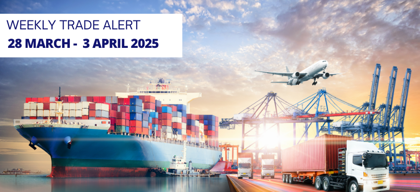All about E-Way Bill in exports

Export Sector
Federation of Indian Export Organisations
149 week ago — 18 min read
In our previous articles we discussed how to start an export business, general provisions regarding export and import, Reserve Bank of India (RBI) regulations for exporters and all about GST under exports. In this article we will address key questions regarding E-Way Bill in exports.
Q. What is an E-Way Bill?
An e-way bill is a document which is required to be carried by a person in charge of the conveyance carrying any consignment of goods of value exceeding fifty thousand rupees as mandated by the Government under the GST regime.
Q. Where can an e-way bill be generated?
It is generated from the GST Common Portal for eWay bill system by the registered persons or transporters who cause movement of goods of consignment before commencement of such movement.
Q. Who all can generate the e-way bill?
The consignor or consignee, as a registered person or a transporter of the goods can generate the e-way bill.
Q. What are pre-requisites to generate the e-way bill?
The person should be a registered person on GST portal and he should register in the eway bill portal separately. If the transporter is not registered person under GST it is mandatory for him to get enrolled on e-waybill portal (https://ewaybillgst.gov.in) before generation of the e-way bill.
Q. What documents are required to generate an EWB?
The documents such as tax invoice or bill of sale or delivery challan and Transporter’s Id, who is transporting the goods with transporter document number or the vehicle number in which the goods are transported, must be available with the person who is generating the e-way bill.
Q. If there is a mistake or wrong entry in the e-way bill, what has to be done?
If there is a mistake, incorrect or wrong entry in the e-way bill, then it cannot be edited or corrected. Only option is cancellation of that eway bill and generating a new one with correct details.
Q. What are the two parts of an EWB?
The two parts of EWB are part A which is filled by the consignee and Part B which is filled by the transporter.
Q. Whether e-way bill is required for all the goods that are being transported?
The e-way bill is required to transport all the goods except exempted under the Notifications or rules. Movement of handicraft goods or goods for job-work purposes under specified circumstances also requires e-way bill even if the value of consignment is less than fifty thousand rupees. Kindly refer to the e-way bill rules for other exemptions.
Q. Is there any validity period for e-way bill?
Yes. Validity of the e-way bill depends upon the distance the goods have to be transported. In case of regular vehicle or transportation modes, for every 100 KMs or part of its movement, one day validity has been provided. In case of Over Dimensional Cargo vehicles, for every 20 KMs or part of its movement, one day validity is provided. This validity expires on the midnight of last day.
Q. Who can extend the validity of the e-way bill?
The transporter, who is carrying the consignment as per the e-way bill system at the time of expiry of validity period, can extend the validity period.
Q. What has to be done, if the validity of the e-way bill expires?
If validity of the e-way bill expires, the goods are not supposed to be moved. However, under circumstance of ‘exceptional nature and trans-shipment’, the transporter may extend the validity period after updating reason for the extension and the details in PART-B of FORM GST EWB-01.
Q. Can I extend the validity of the e-way bill?
Yes, one can extend the validity of the e-way bill, if the consignment is not being reached the destination within the validity period due to exceptional circumstance like natural calamity, law and order issues, trans-shipment delay, accident of conveyance, etc. The transporter needs to explain this reason in details while extending the validity period.
Q. How to extend the validity period of e-way bill?
There is an option under e-way bill to extend the validity period. This option is available for extension of e-way bill before 8 hours and after 8 hours of expiry of the validity. Here, transporter will enter the e-way bill number and enter the reason for the requesting the extension, from place (current place), approximate distance to travel and Part-B details. It may be noted that he cannot change the details of Part-A. He will get the extended validity based on the remaining distance to travel.
Q. What needs to be entered in GSTIN column in case of exports as the recipient does not have GSTIN?
If the consignor or consignee is unregistered taxpayer and not having GSTIN, then user has to enter ‘URP’ [Unregistered Person] in corresponding GSTIN column.
Q. What needs to be entered in Place of delivery column in case of exports in EWB-01?
Generally, Pin code of the place is entered but in case of exports to a foreign country “999999” is entered in EWB-01.
Q. How the distance has to be calculated, if the consignments are imported from or exported to other country?
The approximate distance for movement of consignment from the source to destination has to be considered based on the distance within the country. That is, in case of export, the consignor’s place to the place from where the consignment is leaving the country, after customs clearance and in case of import, the place where the consignment is reached the country to the destination place and cleared by Customs.
Q. What are the documents that need to be carried along with the goods being transported?
The person in charge of a conveyance shall carry the invoice or bill of supply or delivery challan, bill of entry as the case may be and a copy of the e-way bill number generated from the common portal. Please refer relevant rules for details.
Q. How to generate the e-way bill from different registered place of business?
The registered person can generate the e-way bill from his account from any registered place of business. However, he/she needs to enter the address accordingly in the e-way bill. He/she can also create sub-users for a particular business place and assigned the role for generating the e-way bill to that sub user for that particular business place.
Q. What can be done when the importer of goods rejects and returns the goods for any reason?
Under such circumstances, one more e-way bill generated with the help of supplier or recipient by indicating supply as ‘Sales Return’ with relevant documents, return the goods to the supplier as per his agreement with him.
Q. How to handle “Bill to” - “Ship to” invoice in e-way bill system?
Sometimes, the tax payer raises the bill to somebody and sends the consignment to somebody else as per the business requirements. There is a provision in the e-way bill system to handle this situation, called as ‘Bill to’ and ‘Ship to’.
In the e-way bill form, there are two portions under ‘TO’ section. In the left hand side - ‘Billing To’ GSTIN and trade name is entered and in the right hand side - ‘Ship to’ address of the destination of the movement is entered. The other details are entered as per the invoice.
In case ship to state is different from Bill to State, the tax components are entered as per the billing state party. That is, if the Bill tolocation is inter-state for the supplier, IGST is entered and if the Bill to Party location is intra-state for the supplier, the SGST and CGST are entered irrespective of movement of goods whether movement happened within state or outside the state.
Q. How to handle “Bill from” - “Dispatch from” invoice in e-way bill system?
Sometimes, the supplier prepares the bill from his business premises to consignee, but moves the consignment from some others’ premises to the consignee as per the business requirements. This is known as ‘Billing From’ and ‘Dispatching From’. E-way bill system has provision for this.In the e-way bill form, there are two portions under ‘FROM’ section. In the left hand side - ‘Bill From’ supplier’s GSTIN and trade name are entered and in the right hand side - ‘Dispatch From’, address of the dispatching place is entered. The other details are entered as per the invoice. In case Bill From location State is different from theState of Dispatchthe Tax components are entered as per the State (Bill From). That is, if the billing party is inter-state for the supplier, IGST is entered and if the billing party is intra-state for the supplier, the SGST and CGST are entered irrespective of movement of goods whether movement happened within state or outside the state.
Q. How to generate e-way bill, if the goods of one invoice is being moved in multiple vehicles simultaneously?
Where the goods are being transported in a semi knocked down or completely knocked down condition, the EWB shall be generated for each of such vehicles based on the delivery challans issued for that portion of the consignment as per CGST Rule 55 which provides as under:
(a) Supplier shall issue the complete invoice before dispatch of the first consignment;
(b) Supplier shall issue a delivery challan for each of the subsequent consignments, giving reference of the invoice;
(c) eachconsignment shall be accompanied by copies of the corresponding delivery challan along with a duly certified copy of the invoice; and
(d) Original copy of the invoice shall be sent along with the last consignment
Please note that multiple EWBs are requiredto be generatedin this situation. That is, the EWB has to be generated for each consignment based on the delivery challan details along with the corresponding vehicle number.
Q. Who all can update the vehicle number for the e-way bill?
The Vehicle number can be updated by the generator of the e-way bill or the transporter assigned by the generator for that particular e-way bill.
Q. Can Part-B of e-way bill entered/d by any other transporter?
The present transporter can fill or update PART-B of the EWB. The e-way bill can be assigned from one transporter to another transporter, for further movement of consignment. Under this circumstance, the latest transporter, assigned for that e-way bill, can update Part-B of EWB.
Q. If the vehicle, in which goods are being transported, having e-way bill is changed, then what is requiredto be done?
The e-way bill for transportation of goods should always have the vehicle number that is actually carrying the goods. There may be requirement to change the vehicle number after generating the e-way bill or after commencement of movement of goods, due to trans-shipment or due to breakdown of vehicle. In such cases, the transporter or generator of the e-way bill can update the newvehicle numberin Part B of the EWB.
Q. What is to be done (in an EWB) if the vehicle breaks down?
If the vehicle breaks down, when the goods are being carried withan EWB, then transporter can get the vehicle repairedand continue the journey in the same EWB. If he has to change the vehicle, then he has to enter the new vehicle details in that EWB, on the eway bill portal, using ‘Update vehicle number’ option in Part B and continue the journey in new vehicle, within the original validity period of e-way bill.
Q. In case of transportation of goods via rail/air/ship mode, when is user required to enter transport document details, as it is available only after submitting of goods to the concerned authority?
Where the goods are transported by railways or by air or vessel, the Part B of the e-way bill can beupdated either before or after the commencement of movement. But, where the goods are transported by railways, the railways shall not deliver the goods, unless the e-way bill as required under these rules is produced to them, at the time of delivery.
Q. How to handle the goods which move through multiple trans-shipment places?
Some of the consignments move from one place to another place till they reach their destinations. Under this circumstance, each time the consignment moves from one place to another, the transporter needs to enter the vehicle details using ‘Update Vehicle Number’ option in part B of the EWB, when he starts moving the goods from that place. The transporter can also generate ‘Consolidated EWB’ with the EWB of that consignment with other EWBs and move the consignment to next place. This has to be done till the consignment reaches destination. But it should be within the validity period of a particular EWB.
Q. Whether the e-way bill can be cancelled? If yes, under what circumstances?
Yes, e-way bill can be cancelled if either goods are not transported or are not transported as per the details furnished in the e-way bill. The e-way bill can be cancelled within 24 hours from the time of generation.
Q. What is consolidated e-way bill?
Consolidated e-way bill is a document containing the multiple e-way bills for multiple consignments being carried in one conveyance (goods vehicle). That is, the transporter,carrying multiple consignments of various consignors and consignees in one vehicle can generate and carry one consolidated e-way bill instead of carrying multiple e-way bills for those consignments.
Q. Who can generate the consolidated e-way bill?
A transporter can generate the consolidated e-way bills for movement of multiple consignments in one vehicle.
Q. What is the validity of consolidated e-way bill?
Consolidated EWB is like a trip sheet and it contains details of different EWBs in respect of various consignments being transported in one vehicleand these EWBs will have different validity periods.
Hence, Consolidated EWB does not have any independent validity period. However, individual consignment specified in the Consolidated EWB should reach the destination as per the validity period of the individual EWB.
Q. What has to be done, if the vehicle number has to be changed for the consolidated e-way bill?
There is an option available under the ‘Consolidated EWB’ menu as ‘regenerate CEWB’. This option allows you to change the vehicle number to existing Consolidated EWB, without changing the individual EWBs. This generates a new CEWB, which has to be carried with new vehicle. Old CEWB will become invalid for use.
Q. What is bulk generation facility and who can use it?
Through this facility, user can upload multiple invoices and generate multiple e-Way bill at one go. This facility can be used by the taxpayers or transporters who have automated their invoice generation system. In one go, they can prepare bulk requests for e-way bills in a file from their automated system, and upload it on the common portal and generate e-way bill in one go. This avoids duplicate data entry into e-way bill system and avoids data entry mistakes also. Any taxpayer or transporter can use the bulk generation facility.
Q. Why do I need sub-users?
Most of the times, the taxpayer or authorized person himself cannot operate and generate EWBs. He may in that case authorize his staff or operator to do that. He would not like to avoid sharing his user credentials with them. In some firms, the business activities will be operational 24/7 and some firms will have multiple branches. Under these circumstances, the main user can create sub-users and assign different roles to them. He can assign generation of EWB or rejection or report generation activities based on requirements to different sub-users.
This facility helps him to monitor the activities done by sub-users. However, the main user should ensure that whenever employee is transferred or resigned, the sub-user account is frozen / blocked to avoid mis-utilisation.
Q. How many sub-users can be created?
For every principal/additional place of business, user can create maximum of 10 sub-users. That is, if tax payer has only (one) principal business place (and no additional place of business), he can create 10 sub-users. If tax payer has 3 additional places and one principal place of business (i.e., 4 places), then he can create 40 (4 X 10) sub users.
Q. How to generate e-way bill for multiple invoices belonging to same consignor and consignee?
If multiple invoices are issued by the supplier to recipient, that is, for movement of goods of more than one invoice of same consignor and consignee, multiple EWBs have to be generated. That is, for each invoice, one EWB has to be generated, irrespective of the fact whether same or different consignors or consignees are involved. Multiple invoices cannot be clubbed to generate one EWB. However, after generating all these EWBs, one Consolidated EWB can be prepared for transportation purpose, if goods are going in one vehicle.
To learn how to promote your business to foreign buyers, GlobalLinker recently conducted a special webinar with Mr Ashsih Jain, Deputy Director General, FIEO. Watch the highlights below.
Image source: Canva
Disclaimer: The views and opinions expressed in this article are those of the author and do not necessarily reflect the views, official policy or position of GlobalLinker.
Posted by
Federation of Indian Export OrganisationsFIEO is the apex international trade promotion organisation of India. Directly and indirectly it represents the interest of over 200,000 exporters in India. FIEO has 17 offices in...
View Federation of Indian 's profile
Most read this week
Trending













Comments
Share this content
Please login or Register to join the discussion